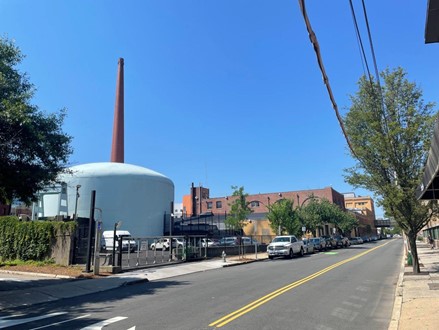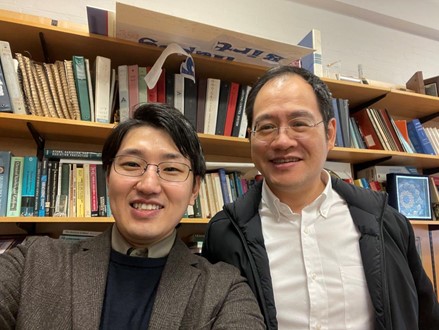2025.03.04
【WRH】 Associate Professor Hiroki Takasu visited MIT
Associate Professor Hiroki Takasu has returned from a six month stay in Massachusetts Institute of Technology supported by the WRH Faculty Research Abroad Program. This is a report on the activities and results of his stay.

The research building (orange building in the far right) next to the MIT Reactor
| Awardee | Associate Professor Hiroki Takasu |
| Destination Institution | Massachusetts Institute of Technology |
| City and Country | Cambridge, USA |
| Host Researcher | Ju Li, Professor |
| Travel Period | 2024/ 6/ 17 ~ 2024/ 12/ 23 (190 days) |
| Project Title | Development of intermediate-temperature CO2 electrolysis cells for high current density operation |

Associate Prof. Takasu on the left and Prof. Ju Li on the right, the last day of the research
Electrolysis of carbon dioxide (CO2) makes it possible to convert CO2 into a useful carbon resource, and so far, mainly two types of electrolytic cells have been used for low-temperature (alkaline and solid polymer electrolyte) and high-temperature (solid oxide electrolyte) applications, which are composed of two types of electrodes and an electrolyte. However, there have been few reports on the development of electrolysis cells that can operate at high current densities in the medium-temperature range, mainly due to material limitations. Therefore, the goal of this joint research has been set as development of CO2 electrolysis cells that can operate at high current densities in the medium temperature range of 160-350℃, and the following content was addressed during the period of visit.
Prior to the experiment, a survey of relevant research was conducted and discussions were held with Professor Ju Li and several researchers regarding the research plan and development targets. After that, we decided to focus on the development of electrolyte materials for electrolysis cells that can be driven in the presence of water vapor, which is an indirect CO2 electrolysis, during the period of this visit. More specifically, it was decided to select candidate materials for proton-conductive solid electrolytes and evaluate them mainly in the medium temperature range of 160-350℃. Since proton conductivity evaluation under a water vapor pressure environment is necessary in actual testing, we also designed and assembled a simple testing device.
Based on a survey of relevant past research, we selected candidates for solid electrolytes with proton conductivity for medium-temperature applications from 2D layered materials and 3D structured materials, and then proceeded to fabricate the electrolytes and evaluate them. For the 2D layered material candidates, we started by carrying out investigations of the synthesis conditions and film formation methods for antimony-containing composite oxides, and then observed the microstructure of the materials and evaluated their proton conductivity in the vertical and horizontal directions. Vacuum filtration was used for the film preparation, and samples separated under different centrifugal conditions were dispersed in aqueous solution to form a film with a thickness of about 30 μm. The obtained film was confirmed to have high proton conductivity in the horizontal direction at temperatures up to around 200°C. In the vertical direction, the proton conductivity was confirmed to decrease significantly to around 1/1000 of that in the horizontal direction, suggesting that proton transfer between the layers of the layered structure is promoted.
For three-dimensional structural materials, we selected titanium phosphate composite materials and evaluated the effects of doping with oxides of different acidities and hydrogenation on proton conductivity. The dopants used were molybdenum oxide, tungsten oxide, niobium oxide, magnesium oxide, and aluminum oxide. For evaluation, we used a mold to perform uniaxial molding to create cylindrical pellets with a diameter of about 1 cm and a height of about 0.5 cm. The proton conductivity of each sample differed by up to about 100 times depending on the type of dopant.
In particular, the samples that had been hydrogenated showed superior performance. However, as the temperature increased, a continuous decline in performance was observed in all samples, so further work is needed in this area, including altering the main composite material.
During this visit, I worked on exploring materials for proton-conductive solid electrolytes that can be used in the medium temperature range. By consistently conducting everything from the synthesis to the evaluation of different materials that I had not previously worked with, several new research seeds were successfully obtained. Due to time limitations, the evaluation was conducted using a simple testing device, but we plan to introduce a testing device for detailed evaluation in the laboratory and continue our research at our research group. In addition, there were frequent opportunities to gather information on seminars and academic conferences at MIT and in the surrounding area, and in fact I had the opportunity to participate in many events (MIT A+B, MITEI annual research conference, various MIT seminars, MRS fall meeting, etc.). At MIT, where interdisciplinary research is particularly active, I was strongly impressed by the underlying emphasis on acquiring knowledge in different fields and promoting interaction between researchers at such events. Through this visit, I was able to experience not only research, but also communication with other researchers and the research style in a foreign country first-hand, which was a very valuable experience. Lastly, I would like to express my heartfelt gratitude for the support of this program, which allowed me to realize this visit.
関連リンク
– World Research Hub (WRH) Program
– Takasu Lab (Japanese)

